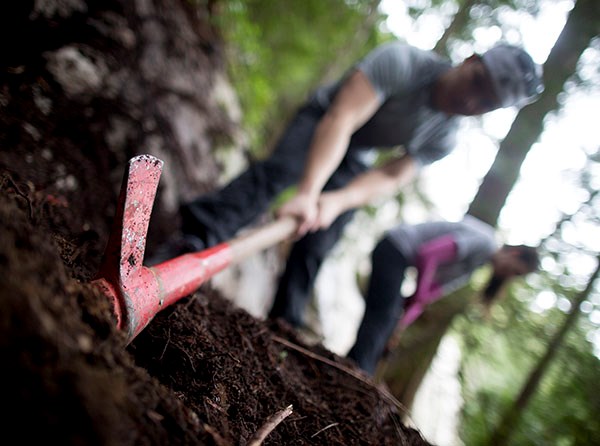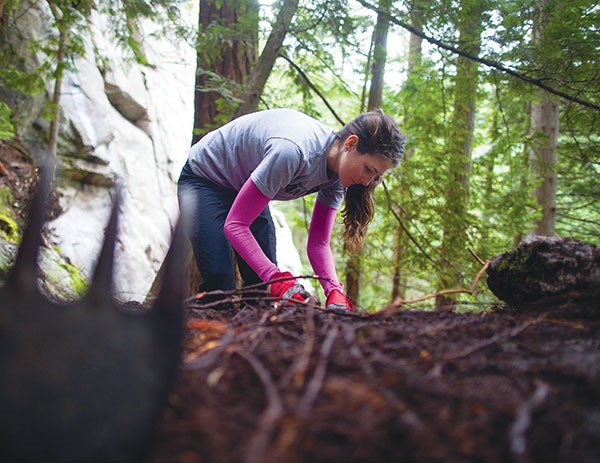Head down, hands clasped behind his back, gait as wide and steady as an athlete half his age, Brian Moorhead makes his way up the newly opened 1.8 kilometre Murrin Loop Trail.
Officially opened to the public in the first week of September, the trail, located in Murrin Park just nine kilometres south of Squamish, leads to two breathtaking viewpoints of Howe Sound and circles past six world-class rock climbing sites.
The area has the second most single-pitch climbs in Squamish, second only to Smoke Bluffs Park.
Moorhead, 76, known to many in Squamish as the Mayor of Smoke Bluffs for his eight-plus years of dedication to the development of the network of trails in that park, could now easily be called the grandfather of the Murrin trail, thanks to his boundless passion for, and oversight of, the building of the loop trail.
But Moorhead prefers to work behind the scenes and so rebuffs credit for the trails at every turn.
“We, not me,” is his common refrain.
And it is true that he has had lots of help.
Moorhead, a director of the Squamish Access Society (SAS) – a local climbers’ organization that works to increase and protect access to Squamish climbing areas – began work on the Murrin Loop Trail in 2012 in partnership with students in the outdoor leadership program at Squamish’s Capilano University.
Over the next two years Moorhead and the students, along with volunteers from other programs and organizations, fashioned much of the dirt, stone and wood trail by hand using materials readily available in the 24-hectare park – such as cedar planks for the footbridges from area trees.
The project also received help in the form of funding from B.C. Parks, Mountain Equipment Co-op and the Squamish Lillooet Regional District.
Before the project, only knowledgeable rock-climbers and the most dedicated hikers accessed the rough, haphazard trails that led to the Murrin rock-climbing walls.
The new loop trail is suitable for all levels of rock climber and hiker.
The building of the Murrin Loop Trail not only opened up recreational possibilities for the close to 400,000 visitors a year who frequent Murrin Park beach, it served, and continues to serve, as an educational experience for many of its young volunteers.
“Both Brian [Moorhead] and I agree that all youth should spend a little time swinging a pick, digging with a shovel – it helps build an ethic of hard work and diligence,” said Don Webster, convenor of the Wilderness Leadership program at Capilano University, in an email. Webster’s students have done much of the hard work of moving stone, harvesting and hauling of dirt and placing of planks necessary to make the trail walkable.
Moorhead plays a big part in educating the youth who volunteer on the trails. Before each work crew sets out, he spends half an hour explaining the process and giving a short history lesson on climbing in the area.
“He’s quick with a joke, inspires the students by still climbing harder than most of them, and isn’t afraid to get his hands dirty,” Webster said.

Outdoor Education instructor Christina Tutsch, from St. George’s School in Vancouver, agrees. She brought 20 Grade 10 boys to do some work on the trail last fall and hopes to come back this year to both work on the trail and get in some climbing.
“Brian is a great role model for young men… he is really calm, and really patient with the boys,” she said.
While the trail is open now, Moorhead has a few more plans up his sleeve that the students can still help with. There are some finishing touches he would like to put on sections of the pathway and he would like to have more benches installed – and an information board at the highest viewpoint to tell a First Nations’ legend of the area.
Asked why he devotes so much time and energy into the unpaid work of building trails and educating young people, Moorhead looked perplexed.
“I don’t think about it, I just do it,” he said.
On further reflection he formed a more philosophical answer.
“The term ‘enduring’ comes to mind,” Moorhead said.
“The people who did the first trails like the Grouse Grind and the first trail into Elfin Lakes area at Garibaldi, that is in 1910 or 1915, I mean these people might have been rocket scientists … but the trails they built have an enduring quality that people benefit from year over year,” he said. “We can look forward to people using these trails for generations, almost, and so it is a simple job, but it is amazingly rewarding in that sense.”
Moorhead pointed out that he and the other trail builders in the Sea to Sky Corridor are carrying on a long tradition that started with new Canadians who came from strong mountaineering cultures – such as British, German and Swiss immigrants in the 1900s.
“My family and I have a lifelong interest in mountaineering, so I see my small contribution to improving Squamish area climbing assets as continuing a long tradition of volunteerism and an important part of the climbing life,” he said.
Moorhead’s son credits his father with “everything” the younger Moorhead has become – an accomplished rock climbing guide and instructor with his own Squamish adventure-guide business.
“We were always out hiking and doing things outdoors growing up,” Colin Moorhead, 39, said, adding that his father allowed him to see what was possible in the outdoors, which led to the younger Moorhead’s career choice.
He attributes his father’s drive to still rock climb and work on trail projects – at an age when many of his peers have retired to a life of leisure – to a passion for the outdoors combined with an extroverted personality.
“He is very social, my dad. He is a very outgoing guy and very friendly and he really likes interacting with lots of people… particularly young, energetic people,” he said. “I guess he is young at heart.”
It could be said the path to Moorhead’s work on this latest trail began 70 years ago when he was a boy growing up exploring the paths along the shoreline cliffs of his hometown, Castlerock in Northern Ireland.
“There were endless opportunities for adventures at a time before overly anxious parenting, where kids were booted out of the house on a summer morning with a jam sandwich and not expected to reappear before supper time. Looking back it is a miracle I did not drown or fall off a cliff,” he said.
Moorhead has packed a lifetime of adventure, travel, rock climbing and trail building into his years.
He came to Squamish in 1967 when the village was a much different place full of loggers and dirt roads. Catering to tourists, as the community does today, would have been unthinkable, he said.
“The local bar had two entrances, ladies and gentleman,” Moorhead recalled, with a shake of his head. “And the surly waiters would bring you five or six pints whether you asked for them or not.”
Though there was rock climbing and hiking going on, few, including Squamish politicians, were paying any attention. It was up to the climbers and hikers to break their own trails.
“There were rudimentary trails not the way it is today,” he said.





